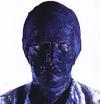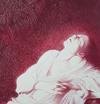Texts and Essays
Irish Independent – July 31, 2001
ONE MAN SHOW IN KILKENNY, 2001
CHILDHOOD DEFILED, STARKLY PORTRAYED
Once an agitated spectator wondered how an apparently nice man could produce such disturbing imagery.
Helnwein replied: "What bothers you is the pictures that get triggered in your own head."
Perusing a catalogue of his work in preparation for a meeting is a journey through disgust, fear, fascination and admiration to finally - almost - attachment.
Patricia Deevy talks to artist Gottfried Helnwein about his grisly depiction of violence, cruelty and torture
His work may no longer inspire nightmares but, as visitors to the Kilkenny Arts Festival are finding out, Gottfried Helnwein is still arresting.
Once an agitated spectator wondered how an apparently nice man could produce such disturbing imagery. Helnwein replied: "What bothers you is the pictures that get triggered in your own head." Perusing a catalogue of his work in preparation for a meeting is a journey through disgust, fear, fascination and admiration to finally - almost - attachment.
The common motif is childhood defiled; the common tension, between innocence and brutality. Controversial early '70s works are beautifully executed paintings of children maimed or scarred in sickening or suggestive ways. Current work includes oversized photo-realist portraits based on a 19th century collection at Austria's anatomical museum. They are of stillborn babies preserved in formaldehyde. "You have the feeling of being close to this being who was there. I think they're beautiful. Each one of them looks different, peaceful." In these later works strangeness is undercut by tenderness.
Some of these paintings are exhibited in Butler House on Patrick Street. Huge head-shots of local children hang on city buildings. Their eyes are closed, "so you know they have an inner life."
A couple of weeks ago a city councillor, Paul Cuddihy, went to Helnwein's castle in Tipperary to figure out if he should remain outraged at another part of the artist's exhibition - a giant photograph of grinning young Nazis adoring a Madonna and child - to be displayed on a wall of the city hall. Cuddihy was satisfied by the artist's anti-Nazi intentions.
It would be ironic if Helnwein was condemned for any kind of supremacism because his life's work had been an interrogation of fascism. He was born in a middle-class Viennese family in 1948: father in the post office, mother at home, three sisters. (Answers to questions about family background are telegraphically brief).
Like most of their generation, his parents didn't talk of the war. "I remember my childhood being surrounded by depressed people. I never heard anybody sing. I never saw anybody laughing. It was really black and dark. There was no art or culture.
"It was a world without pictures really, except in children's books. Then you have in Germany fairytales, but they're all very cruel." The favourite for children was the mid-19th century Struwwelpeter (Slovenly Peter). These were moral fables where misbehaving children met graphically grisly fates.
Catholicism held out the same lesson: sin led to a nasty end. Mind you, so did virtue if you were to believe the lives of the saints. "The only art I really saw was in church. When you go in a church it is an orgy of pictures and you have skulls and skeletons all over the place and dead bishops in glass coffins and the sacred tools for martyrdom and everything."
The first blow against the martyrs was struck by Donald Duck. Disney comics suggested another way of seeing. "I saw these colours and these beautiful drawings and I was really entering a three-dimensional world. I thought I was stepping out of a black and white silent movie into the real world." (Huge menacing Mickey Mouses are now a favourite subject, reflecting his suspicion of the monster capitalist Disney Inc. has become).
In his mid-teens Helnwein did not know how he could make a future. Finally he decided on art. "It's the only thing where I don't have seniors. Where I decide my rules, and still I can do something which has an impact on society."
At his first art school he got bored and one day cut his palms with a razor and used the blood to paint a portrait of Hitler. He was expelled. It was a taste of what was to come: "Aktions" (public artistic happenings) over the next years would involve more cutting, blood and bandages. Once he walked the streets dressed as Hitler, blood spewing from his mouth. It was a way of breaking out of the life he'd been born into - wrongly, he thought - and rules that meant nothing to him.
"[I felt] I don't belong here. My parents are nice: I've never really had a fight. But I don't feel related at all."
At the Academy of Fine Art he was left to work in his own way. His theme was cruelty to children: "I was always so shocked form childhood on about the idea that somebody would get mistreated, abused, tortured. I wasn't mistreated personally but I always thought of things like that. I just painted it because by painting I got it out of my head."
Stickers with the abusive words "Entartete Kunst" - a Nazi term meaning "degenerate art" - appeared on his work in his early exhibitions. (Meanwhile, ironically-intended portraits of Hitler attracted fascist admirers - which raises questions about intentions, meaning and ambiguity in art which are not for here).
Helnwein has researched his subject - violence, cruelty, torture - in depth. "Knowing and feeling it's there is really unbearable for me. I always think if you learn and read and talk you might be able to understand it more."
In 1979 Helnwein's insistence on displaying brutality had a political effect. In an interview after he was appointed Austria's Head of State Psychiatry, Dr. Heinrich Gross admitted that during the war he had poisoned hundreds of handicapped children as a "humane" way of killing them. Shocked that there was no outcry, Helnwein produced a picture of a child slumped over a plate with her face fallen into the food and called it "Life not Worth Living". The debate which ensured led to Gross's resignation.
Through the decades Helnwein had done everything from drawing to opera sets, carried out commissions for the covers of magazines such as Stern and Time (John F. Kennedy and Mikhail Gorbachev), and made a book about Berlin with Marlene Dietrich. His work appears in prestigious collections all over central and eastern Europe and America, particularly its west coast (celebrities love him). Next year he will be the fist western artist to exhibit in Beijing's Forbidden City.
With such a hyperactive international career it's hard to see what brings him to this quiet spot at the foot of the Comeragh mountains where he has lived since 1997. He says after 15 years in Germany he needed a change. "The noise is unbelievable - the real noise and the metaphoric noise. Everything's about being seen and business."
Four years ago Helnwein came to Ireland for the firs time. "You feel a sense of joy inside and freedom and relief that I had not had anywhere else. I thought: 'I was never in my life so happy and I have no idea why.'
"This country has so many qualities which I haven't seen anywhere else that living here is a dream. There's less aggression. Less jealousy. Here you feel there is no class system really."
He hardly knows Vienna any more. His mother died some years ago but his father still lives in the city. They don't see each other much. He says he doesn't feel related to his sisters but that they're nice people and interestingly, like him, they really like children and have big families, though he doesn't know how big.
He is married to Renate, a former psychiatric nurse from southern Germany. Together they have Cyril, Mercedes, Ali Elvis (after two great heroes) and Wolfgang Amadeus (after another). "My life was too stressed or I would have 10 children. I'd like a big table, 20 children, lots of artists, musicians, philosophers and friends and have this cultivated talk which is gone today. In that sense I'm very much Italian inside." (Helnwein is friendly but hardly one's image of a jolly paterfamilias: dressed in black, he is tall, angular, yellow-skinned and over a floppy '70s haircut he wears a black bandanna printed with white skulls.)
The plan is to stay in Ireland "indefinitely". Kilkenny and Tipperary are under his skin now. Even the contours of the land have waylaid him. "I certainly get the desire to paint landscapes - which I never had before."
The Kilkenny Arts Festival runs until next Sunday. Event details from 056 52175 or www.kilkennyarts.ie. Gottfried Helnwein's website is www.helnwein.com.


